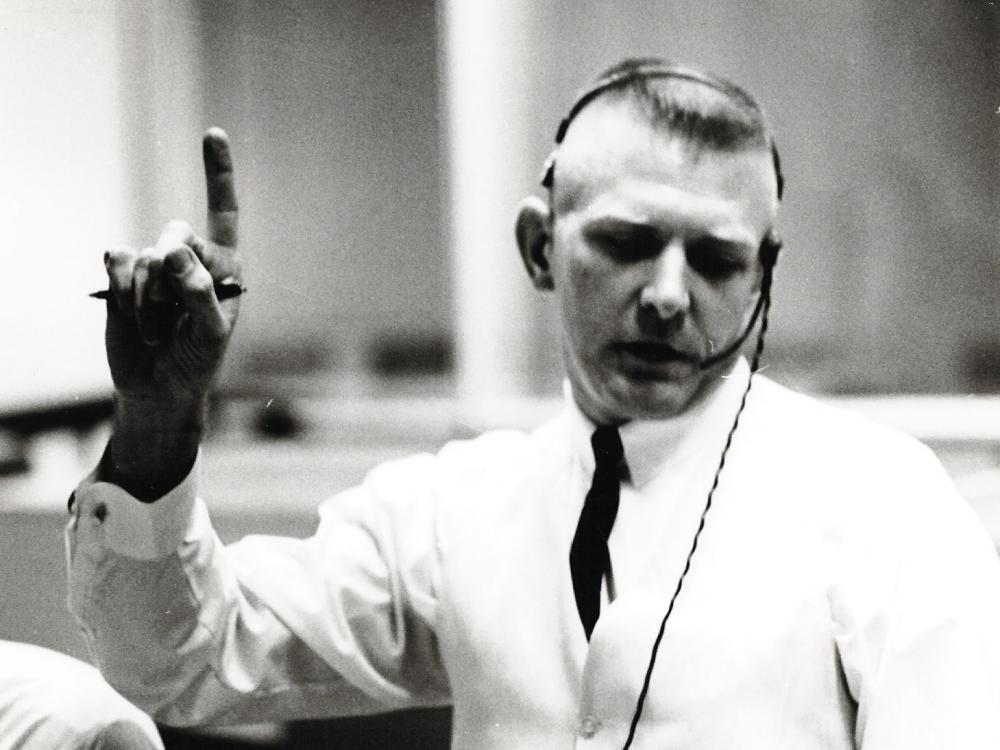
Gene Kranz’s Apollo 13 Vest
Aug 27, 2015

Aug 27, 2015
Gene Kranz is best known for his stellar performance as flight director for the ill-fated Apollo 13 mission. But Kranz is also known for another thing: his white vests. Kranz’s vests had legendary status around mission control, and also in the minds of the public after actor Ed Harris wore an exact replica of Kranz’s most famous vest in the 1995 movie, Apollo 13. Kranz’s vests represented the strong and can-do approach that pervaded his mission control team, especially during the Apollo 13 mission in which the astronauts’ lives were at stake.
Kranz started wearing a different white vest for each mission beginning with the first time he served as flight controller, Gemini IV, on June 3, 1965. Knowing Kranz’s penchant for wearing three-piece suits, his wife, Marta, a skilled seamstress, came up with the idea. She told Smithsonian magazine in April 2010, “There were three Mission Control teams—red, white and blue—and Gene’s was the white team, so his vests were always white.” From that first Gemini mission onward, Marta made a white vest for every launch, plus a second celebratory vest to wear for the splashdown. According to his book, Failure Is Not an Option (2000), Kranz recalled, “I felt like a matador donning his suit as I put on the vest [for the first time].” The splashdown vests were much flashier than the mission versions. However, after Apollo 13 Kranz continued to wear his work vest. You can watch the scene from Apollo 13 where Ed Harris, playing Kranz, puts on the white vest to his team’s applause (fast-forward to 3:24). At the end, you will hear one of the team say, “Hey, Gene, I guess we can go now!”
Eugene F. Kranz wears a special vest to celebrate the shuttle mission STS-41C. Kranz served as the Director of Mission Operations during this 1984 operation.
The story of how the vest came into the Museum’s collection is interesting. Before his appearance as speaker at the John H. Glenn Lecture in 2005, curator Margaret Weitekamp asked Kranz about donating a vest to the national collection. Kranz said he would loan a vest, but not donate one. At the end of the lecture, during the question-and-answer period, a Museum docent in the audience asked him when the Smithsonian Institution would get a vest. Put on the spot, standing next to the Museum’s director and faced with enthusiastic applause from the audience, Kranz announced he had just been talking to a curator about donating one of the vests. Weitekamp, giving an Ask an Expert lecture on the topic later, said, “I didn’t plant the question, but I might have led the applause.” Weitekamp said the Kranz’s thought the Museum would want one of the fancy splashdown vests, but she had another one in mind: the vest from Apollo 13, which she calls “a symbol of how he helped get Apollo 13 back.” Kranz also donated the button he wore on the vest, a duplicate of the mission patch.
Listen to Weitekamp’s Ask an Expert lecture (13:36), which is accompanied by many photos of Kranz’s vests. After the Gemini program, Kranz served as flight controller for odd-numbered Apollo missions. He was on duty for the thrilling moment when the Apollo 11 lunar lander touched down on the Moon on July 20, 1969. His last shift as flight director was Apollo 17 in 1972. He went on to become deputy director of NASA Mission Operations, then director. He retired in 1994. In retirement, Kranz wrote his memoir, Failure Is Not an Option, which was adapted for television on the History Channel in 2003. In 2008, he appeared throughout the Discovery Channel mini-series, When We Left Earth. Kranz is now a motivational speaker, using his experiences with Apollo 13 as the basis for his talks. He continues to wear white vests. As is the tradition at NASA, the color white was retired as a team color from NASA mission control upon Kranz’s departure.

We rely on the generous support of donors, sponsors, members, and other benefactors to share the history and impact of aviation and spaceflight, educate the public, and inspire future generations. With your help, we can continue to preserve and safeguard the world’s most comprehensive collection of artifacts representing the great achievements of flight and space exploration.
We rely on the generous support of donors, sponsors, members, and other benefactors to share the history and impact of aviation and spaceflight, educate the public, and inspire future generations. With your help, we can continue to preserve and safeguard the world’s most comprehensive collection of artifacts representing the great achievements of flight and space exploration.